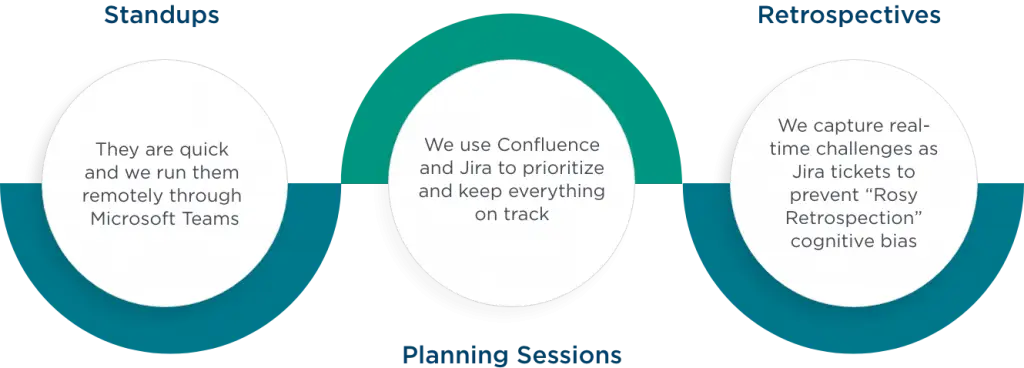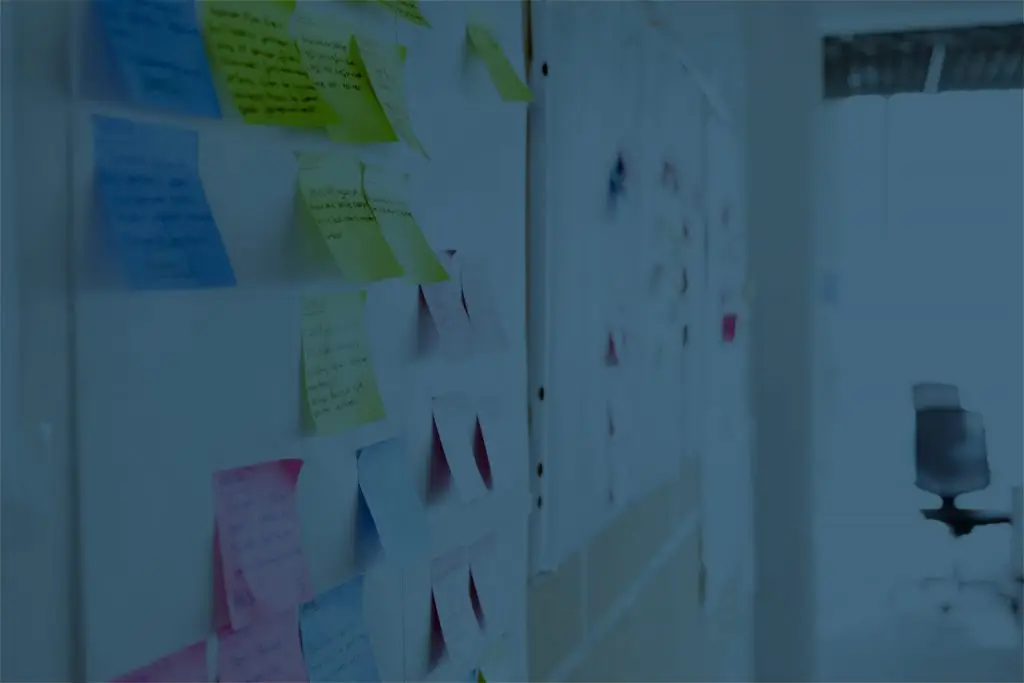Like a majority of the global workforce, the NT Concepts Solution Delivery Teams were thrust into 100% remote work in March. Many of us went from working in the office five days a week to staying at home for days at a time. A new normal was upon us.
This article is about how our Agile teams adjusted (and continue to adjust) to our full-time work-from-home schedules. Agile Ceremonies (Standups, Planning Sessions, and Retrospectives) are foundational in this transition. New working agreements have empowered our teams. We hope our experiences can assist other companies as they evolve their workplace and workforce.
New rules for the new work environment
Before the COVID-19 shutdowns, our teams primarily worked on-site, where we collaborated during in-person Standups, Planning Sessions, and Retrospectives. As the Scrum Master, my role was to protect and support the team while ensuring they followed our Agile Principles. We often rescheduled meetings to ensure we had full on-site participation. Even outside of our ceremonies, our co-located teams functioned well with informal discussions and the shared knowledge through team osmosis.
With the shift to a work-from-home schedule, we experienced some challenges and frustrations. My team and I had to figure out how to communicate, conduct ceremonies, and provide transparency. How could we maintain agility and continue to incorporate best practices and standards in Development, Operations, and Project Management when we could no longer meet in person? Our team’s norms — plus the norms of our partners and customers — had changed in a blink of an eye.
Managing new dynamics wasn’t the only urgent challenge. We also had to navigate the impact of remote work on numerous projects and initiatives. One project (SAFe implementation) posed a major problem because the in-person all hands Product Increment (PI) Planning session was now in limbo. The organization had concurrent Artificial Intelligence (AI) and Machine Learning (ML) projects scheduled to kick-off and countless initiatives and in-person client presentations that couldn’t happen as planned.
To resolve these and other similar challenges, we needed to understand the new circumstances of our team members. Only then could we set expectations and address challenges. Rooted in Agile Principle and CMMI/ISO guidelines, our best practices and operational standards were the foundation for this endeavor. We had honest conversations about the feasibility of meeting expectations and standards, considering the human and mental health of team members. We all listened carefully to understand our teammates’ situations at home and how their circumstances would impact them.
Key takeaways about COVID-era working agreements and norms
Be prompt to Ceremonies and stay on topic
Challenge: Naturally, team members socialize when first joining calls. Camaraderie is great, but it makes it challenging to get everyone’s attention and start a meeting.
Solution: We open our Microsoft Teams audio a few minutes early. Doing so allows us to catch up with teammates without disrupting the meeting.
Results: Meetings start on time and participants stay focused. It also builds team togetherness by allowing everyone to socialize without distracting the larger group.
Capture notes collaboratively
Challenge: Distractions happen. People lose focus. When conducting virtual meetings, team members often had to repeat things, which wasted time and led to frustration.
Solution: Teams collaboratively take notes in Confluence or MS Teams during Planning, Retrospective, and Standup meetings.
Results: The notes become an important artifact for team members and stakeholders to reference.
Evolve and standardize communication methods
Challenge: In-person one-on-one and group meetings are not possible.
Solution: We standardized our collaboration through the utilization of Microsoft Teams and the full suite of capabilities of Office 365. We also organized further by creating sub-channels to reduce noise. Emails are used for formal requests. We continue to use Jira and Confluence for visualizing and collaborating in Standup, Planning, and Retrospective Ceremonies.
Results: Team members maintain collaboration and information-sharing despite the lack of in-person meetings.
Adhere to our best practices and standards
Challenge: In-person code reviews and mob/pair programming are no longer feasible.
Solution: We virtualized our code reviews and mob/pair programming sessions using MS Teams rooted in our Development and DevSecOps best practices.
Results: The team continues to collaborate for code reviews and mob/pair programming while maintaining the highest quality standards for our code.
Redefining each element of agile ceremonies
In addition to changing working agreements and norms, we adjusted the processes and procedures for Agile Ceremony Standups, Planning Sessions, and Retrospectives to ensure that each effort continues to meet our team’s needs within the new working environment.

Standups
Traditionally, these were conducted by gathering the team in the corner of the office or a spare meeting room, but building on our new working agreements, our standups are now different. We run them remotely through Microsoft Teams. A few folks join a little early and do some catching up while others stay on mute. At the meeting time, the Scrum Master starts the Standup and all team members stay focused. Screen-sharing Jira and working through each team member’s issues have become the norm. Team members take notes and post them to our Team Standup Channel.
Planning Sessions
Adjusting our Planning Sessions to a virtual environment was by far the most significant challenge for our teams. Conducting PI Planning virtually posed logistical challenges such as participant limitations on virtual screen share tools, which caused delays impacting 100s of resources. Teams lost the benefits of impromptu conversations and discussions that naturally happen when everyone is in the same place as part of osmosis.
Scheduling between teams also became more challenging without the traditional structure of a SAFe PI Planning agenda. Dependency mapping was difficult without shared physical boards to populate, view, and discuss. It was particularly daunting to review the Sprint backlog and assign work without being together.
We address these hurdles by adding a layer of preparation. We use the Confluence Sprint Planning Template, which helps organize pre-planning and the execution of the Planning Session itself. We also use it as a checklist that we tailor for our project needs. We ensure each team populates issues into Jira before the Agile Release Train (ART) finalizes dependencies. We help them create issues in Jira with enough detail to start the conversations and incorporate dependency mappings across the teams. The benefit of adding Stories to Jira immediately is that teams can link stories and dependencies. Business Analysts can add and confirm with Product Owner’s acceptance criteria to ensure they understand the requirement and add notes to the stories based on Product Owner feedback. We prioritize our backlog and ensure we have well-defined acceptance criteria for each of our Stories. Unexpected benefits come from booking all the participants’ schedules for 2-4 days for PI Planning—teams can invest that time to prepare for their upcoming Sprints.
Retrospectives
Traditionally, retrospectives (Retros) would involve grabbing a conference room, some sticky notes, and collaborating about areas that we’d like to improve and building action items. Remote work challenged that process immediately. To solve for this challenge, we created a Team Retro page and asked everyone to add their responses prior to the Retro. We organized the inputs into categories and weighted them based on how many inputs aligned to each category. When we ran the Retro, the team focused the discussions on their feedback and came up with lessons learned—both positive and areas for improvement. Some of our teams have adopted retrospectives, where they freely discuss the previous Sprints and organize the feedback into different categories. We have found this free-flowing conversational approach helps keep the team engaged throughout the retrospective.
To continue to improve our Retro process, we provide the opportunity to retrospective throughout a sprint. One of the benefits to this approach is that it prevents “Rosy Retrospection” cognitive bias, in which the further away you get from something in the past that you want to improve, the less you will accurately pinpoint what was difficult about the specific issue. We have captured and mitigated this disconnect by adding a Retrospective column to our Kanban board. This step allows us to capture real-time challenges as Jira tickets, rather than thinking back to the past on what was difficult about an issue. This process improves accountability by more frequently and more accurately recording challenging issues to improve.
Continuous improvement and learning
Our teams find it beneficial to hold ad hoc “Scrum of Scrum” meetings to share what has and has not been working for our teams. We discuss how we continue to provide business value to our customers and focus on the correct priorities. We ask ourselves:
- How will this impact our customer relationships?
- What does this process look like in different scenarios (remote, in-person, or a combination)?
- How can we continue to hold ourselves accountable?
- How can we continue to build relationships with one another?
We are active in the Agile community and share what we learn and glean from what others are doing to adjust. Online meetups, webinars, and online conferences are set up to share experiences of what has been working and what hasn’t. We continuously look for improvements to how we work—those small “nuggets” that we use to know when to fail fast and how to improve our solutions.
While the work-from-home situation presents distinct challenges, it also offers the opportunity to evaluate our norms and think critically about Agile Ceremonies. There’s no doubt that we will revert to some in-person best practices when we return to our offices. Incorporating our utilization of our collaboration toolset, formalized documentation in our ceremonies, along with other strategic improvements that we developed working remotely, will allow us to provide efficient and effective ceremonies in support of our Business Objectives.
As you work through this transitional time, know you can call on NT Concepts high-performing teams not only for the optimal business value through our agility, CMMI/ISO standards, and approaches—you also can call on us to discuss your own best-of-breed solution.
